Recent Updates

16 April
Record High Stocks Across the Board Copy
Quick Take: Major stock indices continued to reach all-time highs, as the Nasdaq joined the party.[1] Expectations of fewer rate cuts did little to dampen the rally.
February saw the stock market surge again, as the S&P 500 kicked off its best start to the year (S&P 500 +5.2% in February) since 2019.[2] Market breadth was strong, reflecting a wider recovery across sectors with over 71% of stocks in the S&P posting positive returns.[3]
Investors pushed interest rate cut expectations later into 2024, putting downward pressure on US Treasury bond prices.[4] Rates on 10-year US Treasury yields finished February with its largest monthly increase since the last quarter of 2023 – resulting in lower prices.[5]
Tech Dominance (Again)
The major indices, Dow Jones Industrial Average and S&P 500, had been drumming up a string of record highs since December 2022 and late January 2023, respectively. [6] The rally hit a closing low in December 2022 as investors dumped high value growth stocks sensitive to high rates, leaving the Nasdaq down more than 30% from its November 2021 record high. [7]
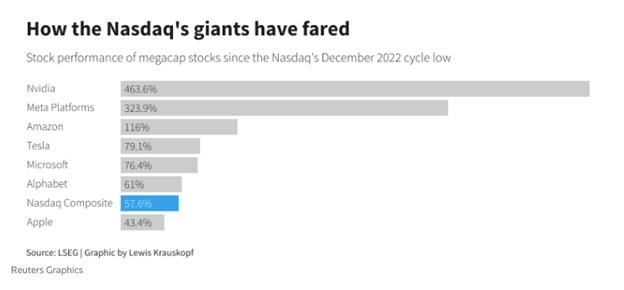
Source: https://www.reuters.com/markets/us/futures-ease-caution-prevails-ahead-inflation-data-2024-02-29/
Since then, the Nasdaq has risen 24%.[8] The Nasdaq’s rise has been led by Nvidia, whose 250% rise over the past year had understandably given investors pause, but its jaw dropping 265% rise in quarterly revenues silenced doubters.[9] The results released late February blew past the most optimistic estimates of Wall Street analysts.[10]
Bubble Talk
Each record high has naturally sparked discussion around a bubble, though Bridgewater founder Ray Dalio notes that the US stock market does not seem to be in a speculative bubble.[11] According to Dalio, although the Magnificent 7 tech stocks leading the charge seem a bit frothy (when assets prices are detached from true intrinsic value), he believes sentiment is still bullish and doesn’t see excessive leverage.[12]
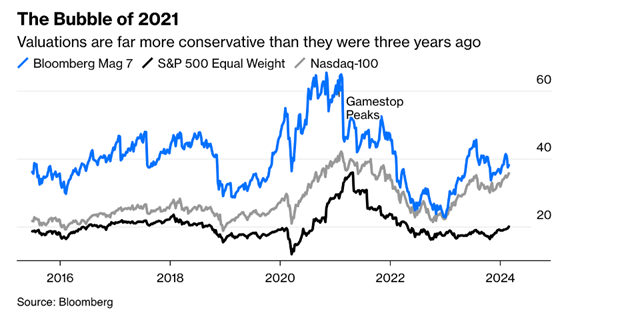
Source: https://www.bloomberg.com/opinion/articles/2024-03-04/gold-rally-the-fed-isn-t-gonna-carry-that-weight?srnd=undefined
Stock valuations are technically far more conservative now than they were three years ago, when meme stocks drove tech names higher.[13] In other words, current prices, while high, are not completely absurd. Of course, the collective expectation that a bubble hasn’t arrived yet could possibly propel gains.
Fewer and Later Rate Cuts
So where does monetary policy figure in all of this? The Fed has remained cautious in its rhetoric, given the economy’s remarkable resilience. Although US prices increased in January, the annual inflation figure was the lowest in three years, which keeps a mid-year interest rate cut on the table.
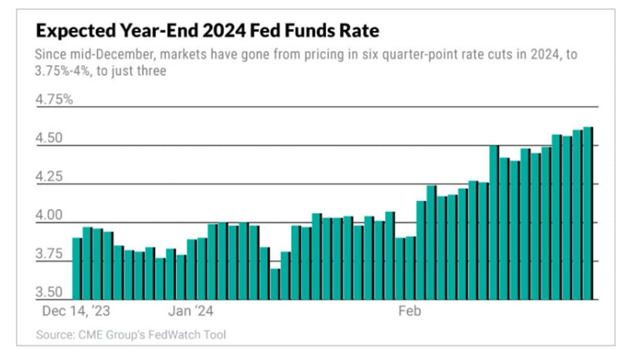
Source: https://www.investors.com/news/economy/fed-rate-cuts-federal-reserve-sp-500/
Since mid-December, markets have gone from expecting six quarter-point rate cuts this year to just three. Three cuts fall right in line with the Fed’s guidance from December.[14]
Fed chair Jay Powell has emphasized the importance of getting the timing of rate cuts right. Starting too early could reverse the progress on inflation and require even tighter policy.
How have markets been so resilient when they now expect fewer interest rate cuts? The reality is that the economy is barely slowing down, and the Fed pivot – the announcement that rates have peaked – has offered a strong tailwind to growth since December.[15] With inflation looking relatively tame, continued strength in the US economy, and a strong employment market, a slower start to the rate-cut cycle might not faze investors. Wall Street strategists have had to scramble to upgrade stock market forecasts.[16]
This is a big shift from near-certain talk of recession going into 2023.
This chart of US forecasts for economic growth as measured by real Gross Domestic Product (GDP) in 2024 shows the about-face.
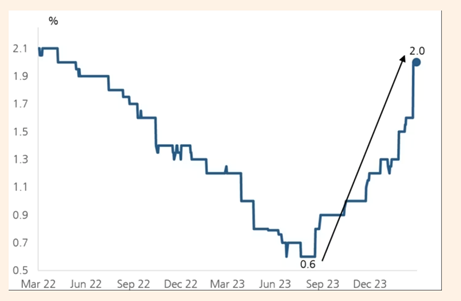
Source: https://www.ft.com/content/0d58cb77-c771-4b05-8e7b-fca2a53e4912
Looking Ahead
Where do we go from here, with stocks at all-time highs? The S&P 500 has risen 7.5% more since reaching all-time highs last December, which tends to make investors nervous about the possibility of a drop.[17]
At this point the hardest thing to do, yet usually the most reasonable, is to stay invested. It’s impossible to predict the direction of the market, and often a fool’s errand to try. Time in the market is more important than timing the market. However, if you anticipate needing funds in the next 6 to 12 months, we believe it is a good time to raise cash.
Looking back in history hints at this – US stocks have been at a record high in 30% of the all the months going back to 1926.[18] In fact, the market often outperforms in the 12 months after reaching an all-time high.[19] Staying in the market delivers meaningful benefits, whereas if you switched into cash at similar points, over 10 years you would have lost 23% of your wealth.[20]
Of course, history doesn’t always repeat itself. Markets tend to follow their own course without taking instructions from the past. They are also meant to be forward looking.
As the first quarter of 2024 ends and we welcome longer spring days with more sunshine, we hope to reconnect soon if we haven’t yet spoken in the new year. Tax season is in full swing, and 1099s continue to become available. The IRA and Roth IRA deadlines are also upon us, mirroring the tax deadline of April 15th. If you have questions, don’t hesitate to reach out to us or your trusted tax professionals as these critical deadlines approach.
As life presents fresh challenges and opportunities, we are committed to providing you a resilient financial strategy that adapts to your evolving needs while keeping your long-term goals in focus. Thank you for your ongoing trust in us and Happy Spring!
Your Friends at JSF
The information expressed herein are those of JSF Financial, LLC, it does not necessarily reflect the views of NewEdge Securities, Inc. Neither JSF Financial LLC nor NewEdge Securities, Inc. gives tax or legal advice. All opinions are subject to change without notice. Neither the information provided, nor any opinion expressed constitutes a solicitation or recommendation for the purchase, sale or holding of any security. Investing involves risk, including possible loss of principal. Indexes are unmanaged and cannot be invested in directly.
Historical data shown represents past performance and does not guarantee comparable future results. The information and statistical data contained herein were obtained from sources believed to be reliable but in no way are guaranteed by JSF Financial, LLC or NewEdge Securities, Inc. as to accuracy or completeness. The information provided is not intended to be a complete analysis of every material fact respecting any strategy. The examples presented do not take into consideration commissions, tax implications, or other transactions costs, which may significantly affect the economic consequences of a given strategy. Diversification does not ensure a profit or guarantee against loss. Carefully consider the investment objectives, risks, charges and expenses of the trades referenced in this material before investing.
Asset Allocation and Diversification do not guarantee a profit or protect against a loss.
The Bloomberg Barclays U.S. Aggregate Bond Index measures the investment-grade U.S. dollar-denominated, fixed-rate taxable bond market and includes Treasury securities, government-related and corporate securities, mortgage-backed securities, asset-backed securities and commercial mortgage-backed securities.
The S&P 500 Index is an unmanaged, market value-weighted index of 500 stocks generally representative of the broad stock market.
TLT-iShares 20 Plus Year Treasury Bond ETF seeks to track the investment results of an index composed of US Treasury bonds with remaining maturities greater than twenty years.
The Nasdaq Composite is a market-capitalization-weighted index consisting of all Nasdaq Stock Exchange listed stocks that are not derivatives, preferred shares, funds, exchange-traded funds or debenture securities.
Treasury Bond- is a U.S. government debt security with a fixed interest rate and maturity between two and 10 years.
Gross domestic product (GDP) is a monetary measure of the market value of all the final goods and services produced in a specific time period. GDP is the most commonly used measure of economic activity.
By clicking on these links, you will leave our server, as they are located on another server. We have not independently verified the information available through this link. The link is provided to you as a matter of interest. Please click on the links below to leave and proceed to the selected site.
Sources:
[1] Nasdaq notches first record high close since 2021 | Reuters
[2] S&P 500 Notches Best February In 9 Years (forbes.com)
[3] S&P 500 Notches Best February In 9 Years (forbes.com)
[4] Review of markets over February 2024 | J.P. Morgan Asset Management (jpmorgan.com)
[5] 10-year Treasury yield ends with biggest monthly jump since October | Morningstar
[6] Nasdaq notches first record high close since 2021 | Reuters
[7] Nasdaq notches first record high close since 2021 | Reuters
[8] Climbing can tell us much about stock market peaks (ft.com)
[9] Climbing can tell us much about stock market peaks (ft.com)
[10] Climbing can tell us much about stock market peaks (ft.com)
[11] Ray Dalio says the U.S. stock market ‘doesn’t look very bubbly’ (cnbc.com)
[12] Billionaire Ray Dalio Doesn’t Think the Stock Market Is in a Bubble (businessinsider.com)
[13] Gold Rally: The Fed Isn’t Gonna Carry That Weight – Bloomberg
[14] Federal Reserve keeps key interest rate unchanged | AP News
[15] Hard –> soft –> refuelling landing
[16] Hard –> soft –> refuelling landing
[17] Climbing can tell us much about stock market peaks (ft.com)
[18] Climbing can tell us much about stock market peaks (ft.com)
[19] Climbing can tell us much about stock market peaks (ft.com)
[20] Climbing can tell us much about stock market peaks (ft.com)
Read more

28 March
Record High Stocks Across the Board
Quick Take: Major stock indices continued to reach all-time highs, as the Nasdaq joined the party.[1] Expectations of fewer rate cuts did little to dampen the rally.
February saw the stock market surge again, as the S&P 500 kicked off its best start to the year (S&P 500 +5.2% in February) since 2019.[2] Market breadth was strong, reflecting a wider recovery across sectors with over 71% of stocks in the S&P posting positive returns.[3]
Investors pushed interest rate cut expectations later into 2024, putting downward pressure on US Treasury bond prices.[4] Rates on 10-year US Treasury yields finished February with its largest monthly increase since the last quarter of 2023 – resulting in lower prices.[5]
Tech Dominance (Again)
The major indices, Dow Jones Industrial Average and S&P 500, had been drumming up a string of record highs since December 2022 and late January 2023, respectively. [6] The rally hit a closing low in December 2022 as investors dumped high value growth stocks sensitive to high rates, leaving the Nasdaq down more than 30% from its November 2021 record high. [7]

Source: https://www.reuters.com/markets/us/futures-ease-caution-prevails-ahead-inflation-data-2024-02-29/
Since then, the Nasdaq has risen 24%.[8] The Nasdaq’s rise has been led by Nvidia, whose 250% rise over the past year had understandably given investors pause, but its jaw dropping 265% rise in quarterly revenues silenced doubters.[9] The results released late February blew past the most optimistic estimates of Wall Street analysts.[10]
Bubble Talk
Each record high has naturally sparked discussion around a bubble, though Bridgewater founder Ray Dalio notes that the US stock market does not seem to be in a speculative bubble.[11] According to Dalio, although the Magnificent 7 tech stocks leading the charge seem a bit frothy (when assets prices are detached from true intrinsic value), he believes sentiment is still bullish and doesn’t see excessive leverage.[12]

Source: https://www.bloomberg.com/opinion/articles/2024-03-04/gold-rally-the-fed-isn-t-gonna-carry-that-weight?srnd=undefined
Stock valuations are technically far more conservative now than they were three years ago, when meme stocks drove tech names higher.[13] In other words, current prices, while high, are not completely absurd. Of course, the collective expectation that a bubble hasn’t arrived yet could possibly propel gains.
Fewer and Later Rate Cuts
So where does monetary policy figure in all of this? The Fed has remained cautious in its rhetoric, given the economy’s remarkable resilience. Although US prices increased in January, the annual inflation figure was the lowest in three years, which keeps a mid-year interest rate cut on the table.

Source: https://www.investors.com/news/economy/fed-rate-cuts-federal-reserve-sp-500/
Since mid-December, markets have gone from expecting six quarter-point rate cuts this year to just three. Three cuts fall right in line with the Fed’s guidance from December.[14]
Fed chair Jay Powell has emphasized the importance of getting the timing of rate cuts right. Starting too early could reverse the progress on inflation and require even tighter policy.
How have markets been so resilient when they now expect fewer interest rate cuts? The reality is that the economy is barely slowing down, and the Fed pivot – the announcement that rates have peaked – has offered a strong tailwind to growth since December.[15] With inflation looking relatively tame, continued strength in the US economy, and a strong employment market, a slower start to the rate-cut cycle might not faze investors. Wall Street strategists have had to scramble to upgrade stock market forecasts.[16]
This is a big shift from near-certain talk of recession going into 2023.
This chart of US forecasts for economic growth as measured by real Gross Domestic Product (GDP) in 2024 shows the about-face.

Source: https://www.ft.com/content/0d58cb77-c771-4b05-8e7b-fca2a53e4912
Looking Ahead
Where do we go from here, with stocks at all-time highs? The S&P 500 has risen 7.5% more since reaching all-time highs last December, which tends to make investors nervous about the possibility of a drop.[17]
At this point the hardest thing to do, yet usually the most reasonable, is to stay invested. It’s impossible to predict the direction of the market, and often a fool’s errand to try. Time in the market is more important than timing the market. However, if you anticipate needing funds in the next 6 to 12 months, we believe it is a good time to raise cash.
Looking back in history hints at this – US stocks have been at a record high in 30% of the all the months going back to 1926.[18] In fact, the market often outperforms in the 12 months after reaching an all-time high.[19] Staying in the market delivers meaningful benefits, whereas if you switched into cash at similar points, over 10 years you would have lost 23% of your wealth.[20]
Of course, history doesn’t always repeat itself. Markets tend to follow their own course without taking instructions from the past. They are also meant to be forward looking.
As the first quarter of 2024 ends and we welcome longer spring days with more sunshine, we hope to reconnect soon if we haven’t yet spoken in the new year. Tax season is in full swing, and 1099s continue to become available. The IRA and Roth IRA deadlines are also upon us, mirroring the tax deadline of April 15th. If you have questions, don’t hesitate to reach out to us or your trusted tax professionals as these critical deadlines approach.
As life presents fresh challenges and opportunities, we are committed to providing you a resilient financial strategy that adapts to your evolving needs while keeping your long-term goals in focus. Thank you for your ongoing trust in us and Happy Spring!
Your Friends at JSF
The information expressed herein are those of JSF Financial, LLC, it does not necessarily reflect the views of NewEdge Securities, Inc. Neither JSF Financial LLC nor NewEdge Securities, Inc. gives tax or legal advice. All opinions are subject to change without notice. Neither the information provided, nor any opinion expressed constitutes a solicitation or recommendation for the purchase, sale or holding of any security. Investing involves risk, including possible loss of principal. Indexes are unmanaged and cannot be invested in directly.
Historical data shown represents past performance and does not guarantee comparable future results. The information and statistical data contained herein were obtained from sources believed to be reliable but in no way are guaranteed by JSF Financial, LLC or NewEdge Securities, Inc. as to accuracy or completeness. The information provided is not intended to be a complete analysis of every material fact respecting any strategy. The examples presented do not take into consideration commissions, tax implications, or other transactions costs, which may significantly affect the economic consequences of a given strategy. Diversification does not ensure a profit or guarantee against loss. Carefully consider the investment objectives, risks, charges and expenses of the trades referenced in this material before investing.
Asset Allocation and Diversification do not guarantee a profit or protect against a loss.
The Bloomberg Barclays U.S. Aggregate Bond Index measures the investment-grade U.S. dollar-denominated, fixed-rate taxable bond market and includes Treasury securities, government-related and corporate securities, mortgage-backed securities, asset-backed securities and commercial mortgage-backed securities.
The S&P 500 Index is an unmanaged, market value-weighted index of 500 stocks generally representative of the broad stock market.
TLT-iShares 20 Plus Year Treasury Bond ETF seeks to track the investment results of an index composed of US Treasury bonds with remaining maturities greater than twenty years.
The Nasdaq Composite is a market-capitalization-weighted index consisting of all Nasdaq Stock Exchange listed stocks that are not derivatives, preferred shares, funds, exchange-traded funds or debenture securities.
Treasury Bond- is a U.S. government debt security with a fixed interest rate and maturity between two and 10 years.
Gross domestic product (GDP) is a monetary measure of the market value of all the final goods and services produced in a specific time period. GDP is the most commonly used measure of economic activity.
By clicking on these links, you will leave our server, as they are located on another server. We have not independently verified the information available through this link. The link is provided to you as a matter of interest. Please click on the links below to leave and proceed to the selected site.
Sources:
[1] Nasdaq notches first record high close since 2021 | Reuters
[2] S&P 500 Notches Best February In 9 Years (forbes.com)
[3] S&P 500 Notches Best February In 9 Years (forbes.com)
[4] Review of markets over February 2024 | J.P. Morgan Asset Management (jpmorgan.com)
[5] 10-year Treasury yield ends with biggest monthly jump since October | Morningstar
[6] Nasdaq notches first record high close since 2021 | Reuters
[7] Nasdaq notches first record high close since 2021 | Reuters
[8] Climbing can tell us much about stock market peaks (ft.com)
[9] Climbing can tell us much about stock market peaks (ft.com)
[10] Climbing can tell us much about stock market peaks (ft.com)
[11] Ray Dalio says the U.S. stock market ‘doesn’t look very bubbly’ (cnbc.com)
[12] Billionaire Ray Dalio Doesn’t Think the Stock Market Is in a Bubble (businessinsider.com)
[13] Gold Rally: The Fed Isn’t Gonna Carry That Weight – Bloomberg
[14] Federal Reserve keeps key interest rate unchanged | AP News
[15] Hard –> soft –> refuelling landing
[16] Hard –> soft –> refuelling landing
[17] Climbing can tell us much about stock market peaks (ft.com)
[18] Climbing can tell us much about stock market peaks (ft.com)
[19] Climbing can tell us much about stock market peaks (ft.com)
[20] Climbing can tell us much about stock market peaks (ft.com)
Read more

29 February
New Year, New Heights
Quick Take: Stocks repeatedly hit all-time highs as they rallied for a third straight month.[1],[2] Fed officials held interest rates steady while Chair Jay Powell all but dashed hopes of a March rate cut.[3]
Stock markets rang in the new year with optimism, notching new record highs to mark a bull run that started in October 2022.[4] Investors have been anticipating an expansion in corporate profits as the economy stays on solid ground, fueled by expected interest rate cuts in 2024.[5]
In the final week of January, a positive Treasury funding announcement (Quarterly Refunding Announcement or “QRA”) pushed the S&P 500 to a sixth record high close for the year.[6] The Treasury Department said it plans to borrow $760 billion in the first quarter, $55 billion lower than expected.[7]
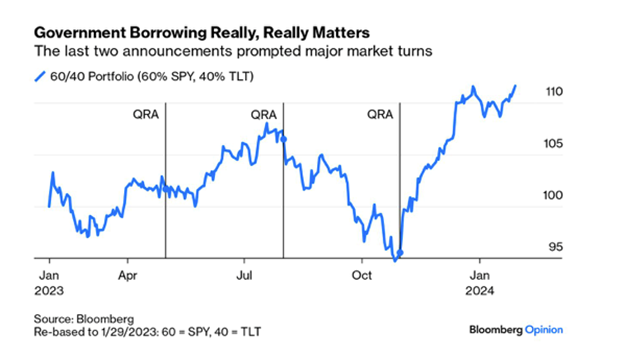
Source: https://www.bloomberg.com/opinion/articles/2024-01-30/world-war-iii-dr-strangelove-or-how-i-learned-to-love-markets (The Bloomberg chart starts the trading day at 100 to easily track the market % up and down)
Investors have become more sensitive to Treasury’s quarterly refunding announcements because of the size of government deficits. The last two quarterly refunding announcements prompted turning points in markets, where the August announcement requiring increased funding spooked investors, while November’s measures to manage debt levels supported a year-end rally.[8]
In January, although the Treasury still boosted the size of its quarterly issuance of long-term debt, they suggested that no more increases would come until next year.[9] This could support demand for Treasurys. By the end of the month, the yield on the benchmark 10-year Treasurys slipped to just below 4%, a hair above where it started the year. Bond prices rise when yields fall.[10]
Solid sentiment in bond markets spilled over into stocks despite Big Tech earnings that weren’t strong enough for Wall Street.[11] Total equity positioning is up to a six-month high.[12] Tech remains dominant, as Big Tech has surged 80% in the past year, while the average stock in the S&P is up only 3%.[13]
Yet for six straight weeks through the end of January, investors poured new money into the largest exchange-traded fund tracking the tech-heavy Nasdaq 100. [14]
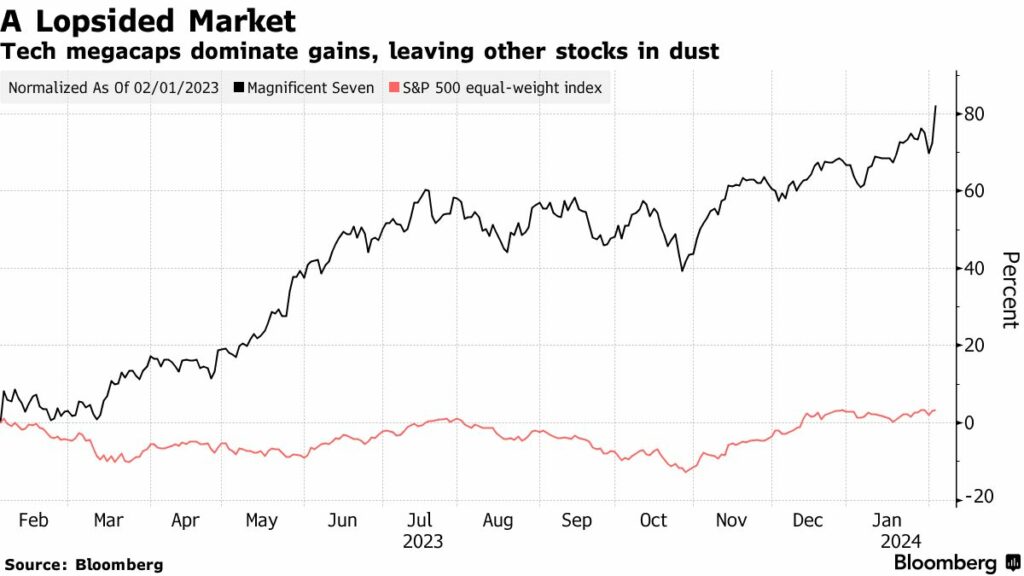
Source: https://www.bloomberg.com/news/articles/2024-02-02/wall-street-bulls-unscathed-even-as-the-big-tech-trade-splinters
Markets dipped after the Federal Reserve (“Fed”) meeting, though major stock market indices logged another positive monthly performance.[15]
Fed Confirms Peak Rates
At the Federal Open Market Committee meeting (“FOMC”), officials held interest rates unchanged while Chair Jay Powell all but dashed hopes of a March rate cut when he called it “unlikely.”[16]
The Fed has pledged to begin rate cuts before the one-year rate reaches its 2% target.[17] Powell acknowledged that inflation has shown encouraging signs, declining to below 2% on a six-month basis. [18] However, he stressed the need to watch data for continued progress before considering rate cuts. [19] The goal is to see inflation on a sustainable path down before easing policy.
As of the December meeting, policymakers envisioned cutting the policy rate by 75 basis points in 2024, with updates of forecasts to come at the March meeting. [20] Given the possible delay in rate cuts, investors shifted their expectations to May as the earliest potential rate cut.[21]
Recent positive economic data has been promising, and Powell notably said that the latest readings showed low unemployment was posing less of a threat to the 2% inflation goal.[22] Data also revealed that US labor costs were cooling more than expected, which should give the Fed room to start cutting rates this year. [23] Companies added a smaller-than-expected 107,000 jobs in January while worker pay growth slowed. [24]
While the Federal Reserve has indicated that interest rates are likely at their peak for this tightening cycle, Powell emphasized that the central bank is not yet ready to declare victory over inflation or declare a “soft landing.” [25] To “stick” a soft landing, they’ll also need to manage interest rates down carefully.
Conflict in the Middle East
One reason Powell might not declare immediate victory over inflation could be raging conflicts abroad.
As the Israeli-Hamas war continues past its third month, tensions that have spilled over include attacks on commercial ships in the Red Sea by the Houthi rebels.[26] Iran-backed Houthis started launching missile and drone attacks at vessels in the Red Sea shortly after the beginning of the conflict, impacting one of the world’s most densely packed shipping channels just south of the Suez canal.[27] Shipping companies are rerouting traffic through slower routes.
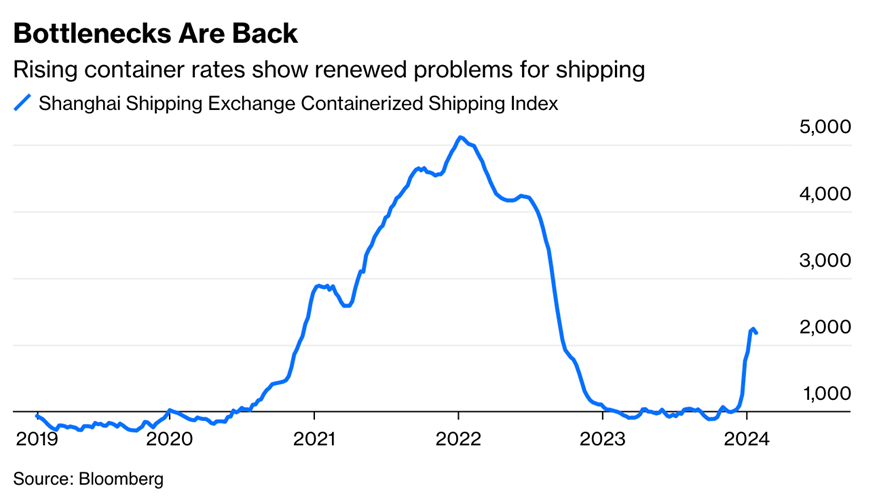
Source: https://www.bloomberg.com/opinion/articles/2024-01-30/world-war-iii-dr-strangelove-or-how-i-learned-to-love-markets
As a result, ocean freight shipping rates are rising. This is a chart showing the price of Shanghai containerized shipping (including routes through both the Panama and Suez canals).
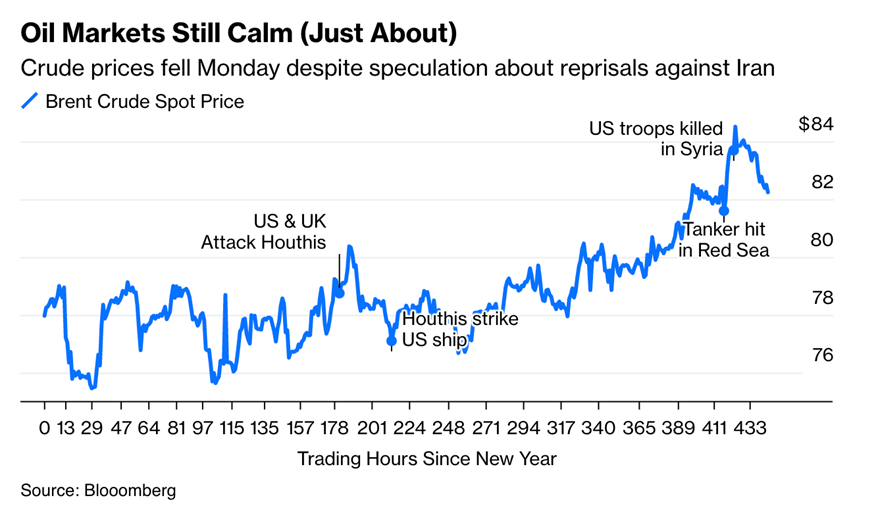
Source: https://www.bloomberg.com/opinion/articles/2024-01-30/world-war-iii-dr-strangelove-or-how-i-learned-to-love-markets
Markets often watch the Middle East with bated breath, wondering if tensions will also ignite oil prices. Wall Street generally relies on the oil market as a barometer, and if oil prices remain stable, they interpret it as a sign that the risk isn’t as significant. So far, as the conflict has broadened, prices of a key benchmark, Brent crude oil, have shifted higher.[28] However, the market seems relatively calm so far, but energy prices remain a risk to monitor.
Looking Ahead
So far, international conflicts seem to have limited impact on US markets. As the S&P 500 hovers around all-time highs, investors have been leaning on signs of a strong economy to power through.[29] Overall financial conditions have also remained accommodative – the biggest surprise of 2023 was probably the level of liquidity available given how aggressively the Fed hiked rates.[30] Some of those conditions may be set to reverse, including the Fed’s program propping up regional banks that expires in March.[31]
How long the stock rally can keep going is anyone’s guess. Longtime readers will know that we don’t jump in the fray of day-to-day market predictions and volatility. The pendulum can swing in either direction at the drop of a hat. That’s why we design our strategies for the long term. The level of risk in your portfolio aligns with your capacity and willingness to take on risk, even in the face of market uncertainties and fluctuations.
Please don’t hesitate to connect with us for a review or a catch-up call if we haven’t had the opportunity to speak directly with you in the new year. We are available to discuss any topics that may be affecting you, whether it be related to the markets and current events, your portfolio, changes in your personal life, or your overarching financial goals. Your thoughts and aspirations are important to us, and we are eager to provide the support and insights you need to help make 2024 a good year for all.
Your Friends at JSF
The information expressed herein are those of JSF Financial, LLC, it does not necessarily reflect the views of NewEdge Securities, Inc. Neither JSF Financial LLC nor NewEdge Securities, Inc. gives tax or legal advice. All opinions are subject to change without notice. Neither the information provided, nor any opinion expressed constitutes a solicitation or recommendation for the purchase, sale or holding of any security. Investing involves risk, including possible loss of principal. Indexes are unmanaged and cannot be invested in directly.
Historical data shown represents past performance and does not guarantee comparable future results. The information and statistical data contained herein were obtained from sources believed to be reliable but in no way are guaranteed by JSF Financial, LLC or NewEdge Securities, Inc. as to accuracy or completeness. The information provided is not intended to be a complete analysis of every material fact respecting any strategy. The examples presented do not take into consideration commissions, tax implications, or other transactions costs, which may significantly affect the economic consequences of a given strategy. Diversification does not ensure a profit or guarantee against loss. Carefully consider the investment objectives, risks, charges and expenses of the trades referenced in this material before investing.
Asset Allocation and Diversification do not guarantee a profit or protect against a loss.
The Bloomberg Barclays U.S. Aggregate Bond Index measures the investment-grade U.S. dollar-denominated, fixed-rate taxable bond market and includes Treasury securities, government-related and corporate securities, mortgage-backed securities, asset-backed securities and commercial mortgage-backed securities.
The S&P 500 Index is an unmanaged, market value-weighted index of 500 stocks generally representative of the broad stock market.
TLT-iShares 20 Plus Year Treasury Bond ETF seeks to track the investment results of an index composed of US Treasury bonds with remaining maturities greater than twenty years.
The Nasdaq Composite is a market-capitalization-weighted index consisting of all Nasdaq Stock Exchange listed stocks that are not derivatives, preferred shares, funds, exchange-traded funds or debenture securities.
Treasury Bond- is a U.S. government debt security with a fixed interest rate and maturity between two and 10 years.
Gross domestic product (GDP) is a monetary measure of the market value of all the final goods and services produced in a specific time period. GDP is the most commonly used measure of economic activity.
By clicking on these links, you will leave our server, as they are located on another server. We have not independently verified the information available through this link. The link is provided to you as a matter of interest. Please click on the links below to leave and proceed to the selected site.
[1] https://www.wsj.com/finance/stocks/global-stocks-markets-dow-news-01-31-2024-e0dcca54
[2] Dow Jones, S&P 500 score 6th record close of 2024, bolstered by Treasury funding update in pivotal week for markets | Morningstar
[3] Fed meeting today: Live updates on January Fed rate decision (cnbc.com)
[4] S&P 500 confirms bull market with record close | Reuters
[5] Stocks Are in a Bull Market. What Does That Mean? – The New York Times (nytimes.com)
[6] Dow Jones, S&P 500 score 6th record close of 2024, bolstered by Treasury funding update in pivotal week for markets | Morningstar
[7] Dow Jones, S&P 500 score 6th record close of 2024, bolstered by Treasury funding update in pivotal week for markets | Morningstar
[8] World War III: Dr. Strangelove, or How I Learned to Love Markets – Bloomberg
[9] S&P 500 Has Its Worst Fed-Decision Day Since March: Markets Wrap (yahoo.com)
[10] Stocks Start 2024 With Third Straight Month of Gains – WSJ
[11] Big Tech earnings are here. Fasten your seat belts. (yahoo.com)
[12] Bull Market in Stocks Powers Even as the Big-Tech Trade Splinters – Bloomberg
[13] Bull Market in Stocks Powers Even as the Big-Tech Trade Splinters – Bloomberg
[14] Bull Market in Stocks Powers Even as the Big-Tech Trade Splinters – Bloomberg
[15] https://www.wsj.com/finance/stocks/global-stocks-markets-dow-news-01-31-2024-e0dcca54
[16] Fed meeting today: Live updates on January Fed rate decision (cnbc.com)
[17] Fed meeting today: Live updates on January Fed rate decision (cnbc.com)
[18] Fed meeting today: Live updates on January Fed rate decision (cnbc.com)
[19] Fed meeting today: Live updates on January Fed rate decision (cnbc.com)
[20] Fed’s Powell sees lower rates on the horizon as inflation ebbs, economy bounces ahead | Reuters
[21] Fed’s Powell sees lower rates on the horizon as inflation ebbs, economy bounces ahead | Reuters
[22] Jay Powell says Federal Reserve interest rate cuts in March are ‘not base case’ (ft.com)
[23] S&P 500 Has Its Worst Fed-Decision Day Since March: Markets Wrap (yahoo.com)
[24] S&P 500 Has Its Worst Fed-Decision Day Since March: Markets Wrap (yahoo.com)
[25] Fed meeting today: Live updates on January Fed rate decision (cnbc.com)
[26] How Middle East escalation could impact oil prices & global trade in the Red Sea : The Indicator from Planet Money : NPR
[27] Who are the Houthis and how did the US and UK strikes on Yemen come about? | Yemen | The Guardian
[28] World War III: Dr. Strangelove, or How I Learned to Love Markets – Bloomberg
[29] Bull Market in Stocks Powers Even as the Big-Tech Trade Splinters – Bloomberg)
[30] Are We in a Bull Market Yet? (morganstanley.com)
[31] The End of Easy Money (morganstanley.com)
Read more